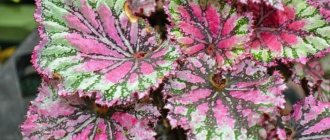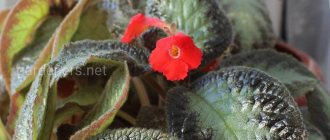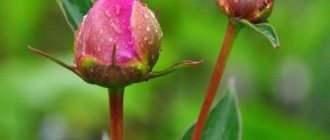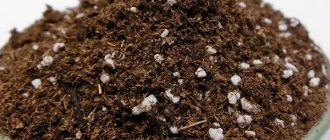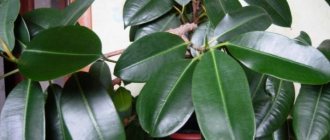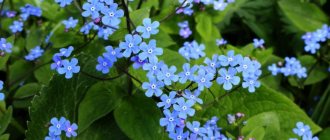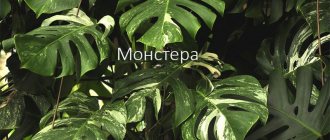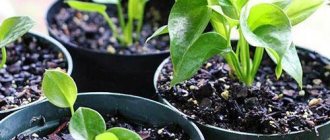Introduction
The eye-catching plant has long been noticed and studied far and wide by both scientists and amateur gardeners.
The first called the unusual flower episcia - lilac, creeping, copper, dotted, carnation, and the indigenous inhabitants of the American continent, ignorant of sophisticated scientific names, with the plant’s native climate, gave episcia such wonderful names as violet flame, orange violet, African violet , a peacock flower and even a chameleon plant.
Continuous selection periodically presents new varieties, and often amazes with the invention of completely unique leaf colors , from chocolate to silver, from crimson to purple, from light green to pearlescent.
This touching plant, covered with the most delicate leaves, does not leave you indifferent with the enchanting beauty of its flowering - multi-colored, delicate, bright buds scatter against the background of patterned leaves, and delight with the long-term extent of its flowering , approximately starting in March and lasting until mid-November.
Botanical description
Episcia refers to ampelous herbaceous perennials with a fibrous root system. The leaves, decorated with characteristic silvery threads, are located oppositely on a shortened creeping stem.
The plant reproduces with tendrils - creeping shoots. Episcia's “favorite” soil is leaf soil, peat and sand, mixed in a ratio of 3:2:1.
Episcia shoots come in two types:
- kurguznye with folded opposite leaves;
- graceful, thin, elongated in shape with daughter rosettes.
Episcia leaves are large, elliptical, sometimes ovoid. The foliage of different plant species can be wrinkled, velvety-pubescent or shiny, olive green, copper-brown or silver in color, veined in a contrasting tone or green with a copper or silver pattern.
For your information! There are a large number of plant hybrids, distinguished by unusual foliage colors. It can be chocolate brown, raspberry pink with silver veins, light green with white and coral vessels, brown with pink pearl veins.
Flowers
Flowers of all types of episcia are formed in the axils of the leaves. They are small, tubular in shape, very beautiful, often solitary, and have four stamens. The corollas of the flowers are colored white, red, yellow, golden and pink-purple.
At home, episcia with bright red flowers takes root well. This may be why flower growers call the plant fire violet. In the wild, episcia blooms yellow, white and orange. Hybrid flowers can be bright orange, lavender blue or light cream.
Note! The flowering period is all summer and early autumn.
Characteristics of episcia types
Root system: fibrous, medium developed.
Stem: soft, thin, long or short with densely spaced leaves, creeping.
Important: Episcias are cultivated as hanging flowers, suitable for life in hanging pots, precisely due to the formation of long shoots after the stem has drooped, hanging over the edge of the pot.
Leaf blades: finely crenate along the rim, oppositely located, rather large, densely pubescent, with a shiny/matte/smooth surface; the color palette is very diverse, and rarely green.
Leaf Shape:
- Elliptical
- Broadleaf
- Broad-ovate
Important: a distinctive feature of episcias is the crazy variety in leaf colors. The emphasis is rarely placed on the green color of the leaves, although its unique speckled patterns in shades of marsh and light green look no less magical than golden tiger with brown, or dusty pink with thick scarlet pubescence.
Flowers: axillary “gramophone” 3 x 2 cm; in shades of scarlet, orange, lavender, blue, cream, yellow and pink (for example, episcia copper); rarely – speckled; each flower has 4 stamens; single; tubular.
Diseases and pests
It is not often that the plant is attacked by indoor pests. If this happens, it is due to non-compliance with care rules, dry air or contamination of the substrate. Mealybugs, aphids and root nematodes that appear under such conditions are eliminated with insecticides, for example, actellik. The diseased plant is first sprayed with a dissolved insecticide, then the substrate is watered until liquid is released from the bottom of the pot through the drainage hole.
Infection with nematodes is accompanied by the formation of root tumors - in this case, nothing can help the plant, so cuttings are cut from it, the soil is disposed of, and the container is boiled. To alleviate difficult periods in the development of episia, such as transplantation, sudden changes in housing conditions, and so on, it is advisable to use bioregulators, for example, Epin. Treatment of plants with epin is carried out no more than once every 7-10 days. The reasons for the lack of flowering may be improper lighting conditions and waterlogging of the substrate, which is fraught with the appearance of a sign of rotting of the root system - general lethargy of the plant.
Varieties and names with photos
| Type of epic | Leaves | Flowers |
| Dianthiflora episcia dianthiflora | Oval, pubescent, in shades of green | White, tubular, carnation-like |
| Type of epic | Leaves | Flowers |
| Creeping episcia reptans | Hairy, silver-green | Carmine, edged with fringe |
| Copper-red episcia cupreata | Elliptical, large, brown to copper | Yellow corolla, red spots |
| Type of epic | Leaves | Flowers |
| Chocolate soldier episcia chocolate soldier | Brown-green, silver-blue dots | Dark burgundy |
| Type of epic | Leaves | Flowers |
| Forest beauty episcia silvans beauty | Glossy, in shades of silver | Carmine, red |
| Type of epic | Leaves | Flowers |
| Northern lights episcia northern light | Glossy, pearlescent shimmer | Reds |
| Silver shine episcia silver sheen | Hairy, shades of silver, edged with green or brown stripes | Orange-red |
| Type of epic | Leaves | Flowers |
| Lilacina viridis | Large, pubescent, finely toothed, emerald green, with a scattering of silver veins | Lavender, lilac, with white rim |
| Kee wee | Large, rough, shiny, with a brown coating | Orange-red, yellow throat |
| My precious | Large, glossy, lumpy, green-light green, with pearlescent veins | Yellow, lightened edge |
| Type of epic | Leaves | Flowers |
| Yellow mist | Large, smooth, with silvery pearl scattering along the veins | Bright yellow |
| Type of epic | Leaves | Flowers |
| Gray lady | Hairy, medium, jagged, in olive shades | Red, orange, yellow polka dots |
| Silver dust | Medium, dark, olive green, with contrasting mesh veining | Carmine, orange, edged with a light rim |
| Type of epic | Leaves | Flowers |
| Faded jade | Light green, with pearlescent coating along the central | Orange-red, yellow throat |
| Сhocolate cream | Chocolate brown with wide pink veins | White, fringed edges |
| Type of epic | Leaves | Flowers |
| Silver skies | Miniature appearance, in shades of green, with a crimson tint | Carmine |
| Tiger stripe | Swamp shades, with veins similar to the pattern of tiger skin | Scarlet |
| Type of epic | Leaves | Flowers |
| Pink acajou | Medium, finely toothed, silver-green, with random pink splashes | Carmine |
| Type of epic | Leaves | Flowers |
| Moon light | Light silver, with brown-pink edge | Reds |
| Sun gold | Small, olive, with brown tones, shiny, herringbone | Bright yellow |
| Type of epic | Leaves | Flowers |
| Butternut | Light green, with brown spots, young leaves - pink shades | Reds |
| Type of epic | Leaves | Flowers |
| Spring symphony | Glossy, large, dark olive | Orange, jagged edges |
| Aloha mauna loa | Round, hairy, dark brown tortoiseshell color | Orange-red |
| Type of epic | Leaves | Flowers |
| Pink Panther | Hairy, dark green, herringbone pattern | Hot pink, jagged |
| Type of epic | Leaves | Flowers |
| Country kitten | Small, embossed, chocolate-colored, with silver-pink veins | Red-orange |
| Sea foam | Round, pubescent, raspberry-pink in color, with a pink border and an olive stripe | Orange-red, yellow throat |
| Type of epic | Leaves | Flowers |
| Veronica's hair | Cherry, with mother-of-pearl insert | Scarlet |
Episcia varieties for home cultivation
The most widely used names of Episcia varieties are:
- Pink Panther. Popular due to its unpretentiousness. It has small dimensions, bright pink large flowers, lime-green or bronze-green foliage up to 15 cm.
- Pink akazhu. It has silver-green foliage with pink splashes and whitish-green stitches. The inflorescences are orange-red with a yellow throat.
- Strawberry patch. The flowers, like those of the pink akaju, have a yellow throat and scarlet color. The leaves of this episcia variety are sharp, small and bright pinkish-red in color.
- Tiger stripe. It is distinguished by small foliage and silvery veins. Otherwise, it is similar to the Muscovite brindle, which has golden veins.
- Chocolate cream. This episcia variety has red flowers. The leaves of this variety are silvery brown. The plates are also covered with a pinkish mesh.
- Ronnie. Coral-red flowers look especially impressive against the background of chocolate-brown leaves.
- Degas. This variety has red inflorescences and brown-green leaves. The plates are covered with deep green veins.
There are other varieties of this indoor decorative flowering plant, but they are not widespread.
Episcia care
Lighting
Preferably a bright room, 12-16 hours of daylight, no direct sunlight.
Air temperature and humidity
Heat-loving episcia loves moderate temperatures and high air humidity; its homeland is shady tropical forests.
- Night: +18С/+25С
- Day:+24С/+26С
- Winter: not lower than +15C
- Summer: no higher than +33C
Watering
Moderate, only with settled water, and drain excess liquid from the pan an hour after watering.
Transfer
It is recommended to replant the episcia annually in early or mid-March, provided that the entire native soil for the plant is filled with the root system, and individual root branches protrude outside the pot holes.
Important: Episcia will bloom only when the root system has completely colonized the soil of the pot, and not earlier.
Landing location
Depending on the species, epicia prefers planting in wide and low pots that meet the needs of specific root systems.
Accordingly, for more sprawling and large-leaved species, the container is chosen to be much larger than for dwarf species.
Soil selection
In the soil for epistation, increased air permeability and lightness are required, with a pH of approximately 6.0. It would be a good idea to enrich the selected soil with fine charcoal.
Tip: To make it easy for water to penetrate to the roots without causing oversaturation and rotting, be sure to dilute the bottom layer of soil with pebbles, or add drainage.
Top dressing
In summer, every fourteen days. It is worth choosing mineral complexes and fertilizers rich in organic matter, and preparing them, reducing the proposed norm to half a serving.
Here's some advice from professionals:
Correct bush formation
Forming a charming bush from the plant does not cause any difficulties. Following this desire, you need to plant the plant in a wide pot, but better - in a shallow one, and lightly sprinkle the young shoots with soil, pulling them to the ground.
You won’t have to wait long - the plant will quickly take root , produce new rosettes, and in the vast majority of cases, take root there, in its own pot.
Distribution area
Episcia - home care, propagation by leaves and cuttings
The homeland of various types of Episcia is the tropical forests of South and Central America. The plant can be seen in the Antilles, Colombia, Mexico and Brazil, in shaded areas with high humidity.
Important! Indoor episcia is an unpretentious plant. It can grow and develop under artificial light. You just need to make sure that in winter the daylight hours last for at least 12 hours. Light, even artificial, strengthens the plant and prolongs its life. In a room it can be grown in a sunny window with an air humidity of 50% or less.
According to another source, too bright lighting affects the size of the foliage - it turns pale, becomes smaller, or even stops growing altogether.
Episcia propagation on a windowsill
Vegetative propagation of Episcia
The easiest way to reproduce. Separate the young rosette from the main plant near the mother trunk and place it in a container of water.
Within a week or two, the shoot should produce a root, after which it can be transplanted into a pot.
Tip: There is a way to root directly in a pot with the main adult plant - a shoot on a tendril is dug into the ground and sprinkled on top. After a month, carefully disconnect it from the adult plant and dig it up, replanting it in its own pot.
Episcia leaf propagation
A labor-intensive and long-term method of propagating episcia, in which new plants are unlikely to surprise with their large size. Rooting occurs in a greenhouse , followed by acclimation to the air.
Episcia from seeds
The most thankless and almost impossible method of reproduction for apartment conditions. Seeds are sown in containers heated from below, lightly added with water, covered with film on top, and a strict microclimate is maintained.
After the seedlings grow, they are transplanted into the smallest independent pots possible.
Important : with the seed propagation method, the innovations of the variety are lost without a trace - to preserve the uniqueness, methods of cutting and leaf separation are used.
Flower propagation methods
dianthiflora , watercolor and Dutch are grown in indoor floriculture . Both species, along with other varieties, are quite easily propagated by stem cuttings, as well as individual leaves and seed material. Seed propagation causes loss of varietal characteristics and is therefore used extremely rarely.
The simplest and most convenient method of propagation for gardeners is the rooting of side shoots. In this case, well-developed shoots with three or four nodes are placed in clean water at a depth of approximately 30-40 mm, and after the roots appear, they are planted in a permanent place. As a rule, there are no problems with rooting stem cuttings, and the entire process takes no more than a week.
The simplest and most convenient method of propagation for gardeners is the rooting of side shoots.
It should be taken into account that for rooting, the temperature indicators of the nutrient soil composition cannot be lower than 18-22 ° C. Young plants, as they grow and develop, need to be replanted using the transshipment method, without disturbing the earthen coma. is very easy to propagate a decorative, beautifully flowering crop from stem cuttings , rooting them directly in a nutritious soil substrate.
In the first two weeks, it is advisable to provide the rooted cuttings with a greenhouse effect. The optimal substrate for growth and development is a substrate based on leaf soil, peat and medium-grained sand, mixed in a ratio of 3:1:1, with the addition of a small amount of sphagnum and crushed charcoal.
In the first two weeks, it is advisable to provide the rooted cuttings with a greenhouse effect
Why episcia does not bloom and other care problems
If episcia does not bloom
What to do if the plant does not want to bloom:
- transplant into a smaller pot,
- give more light
- use special fertilizer.
If episcia leaves turn yellow
Most likely, in this case, the plant has oversaturation with sunlight or light burn. Need to:
- prevent direct sunlight from hitting the flower,
- insufficient amount of nutrients in the soil,
- oversaturation with fertilizers.
If a gray coating appears on the leaves
Pest damage is possible; in this case, the air humidity should be increased and the plant should be treated with an appropriate insecticide. This symptom also occurs with a fungal disease or increased acidity of the soil.
If brown spots appear on the leaves
- the plant needs more air humidity,
- fungal disease.
Sometimes the cause of spots can be cold water coming into contact with delicate leaves during watering.
Attention! Under no circumstances should you spray the leaves or pour water on them from a watering can; water only under the stem.
If episcia does not grow
Most likely, the container is too large - the plant produces a root system without growing.
If the leaves turn yellow and rot
The reasons may be:
- overflow and stagnation of water,
- rotting may occur during propagation and replanting.
In this case, all shoots with rosettes are immediately cut off and replanted.
If the buds and leaves curl and fall off
Possible reasons:
- Drying by sunlight
- Parasite damage.
It is necessary to remove the causes of this phenomenon.
Questions and answers
- Why does Episcia refuse to bloom?
The flowering period may not occur due to insufficient watering, excessive dryness, too low a temperature if it drops below 18 degrees, or lack of lighting. Sometimes the problem lies in an excess of nitrogen-containing fertilizers when the green mass is actively developing.
- Why do the leaves curl and the buds fall off?
The reason for this phenomenon is excessively dry indoor air and insufficient watering.
- Has Episcia stopped growing?
An ornamental flowering plant refuses to grow when the room temperature is too low and there is too little lighting. To correct the situation, the pot with episcia is moved to a western or eastern window, and the temperature is maintained above 18 degrees.
Rate this post
Watering rules
Water the plant in such a way that water flows out of the drainage hole made in the bottom of the flowerpot. The plant is watered after making sure that the soil surface is completely dry after the previous irrigation.
In summer, the recommended watering frequency is once every 2-4 days. If it is noticed that too much moisture has accumulated in the pan, the excess is drained, thereby preventing rotting of the root system. At the same time, it is necessary to ensure that the earthen lump is not too dry.
During the winter months
During the winter months, the plant must be protected from drafts, first of all paying attention to the location of the flowerpot. During the heating season, the plant must be kept away from heating appliances.
The watering schedule for the plant in winter depends on the room temperature. In the cold season, the flower is watered from one to three times a week.
Experienced gardeners urge their inexperienced colleagues to refrain from spraying episcia. Over time, water procedures, of course, will become a habit and become a kind of ritual. But first, a beginner must observe the plant, feel it... Spraying carried out improperly can result in drying out of the tips of the leaves, stunting of growth, or other troubles.
This is the only warning when growing a flower. In general, it is easy to care for and does not cause any trouble.
